High Fiber Diet Benefits
In this article, Neal Barnard, MD, author, and president of the Physicians Committee for Responsible Medicine (PCRM), shares his tips on how a low-fat, high-fiber diet can help you lose weight, improve health, and fight cancer.
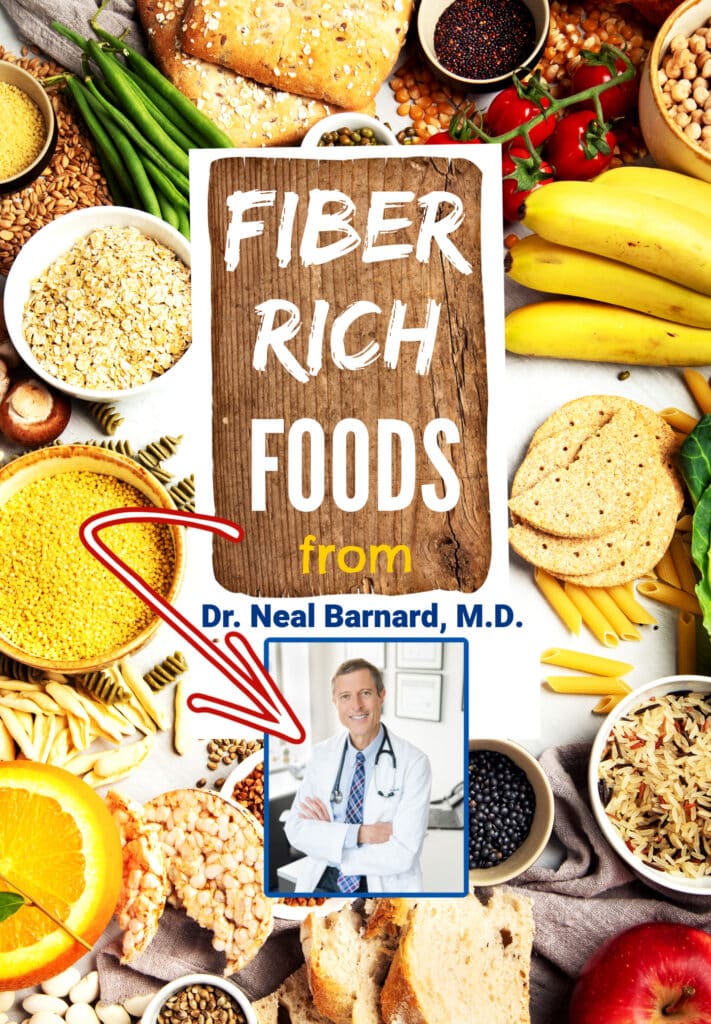
Dietary changes can help reduce the amount of estrogen and testosterone in the bloodstream. Fiber is a key part of this. Fiber has other important benefits too, as we’ll see in this article.
Although many factors may be at work here, let us focus first on one key biological fact: Hight-fat, low-fiber foods boost the hormones that promote cancer.
“Fiber” is another word for plant roughage–the part of beans, grains, vegetables, and fruits that resists digestion. Fiber helps to keep us regular by moving the intestinal contents along. But, it has other equally important roles. It helps us rid ourselves of all manner of chemicals–including hormones–that our bodies are anxious to eliminate.
| Only plant foods have fiber. There is no fiber in meat, dairy, or eggs. |
This “waste disposal” system starts in your liver, which continuously filters your blood. As blood passes through the liver’s network of tiny capillaries, liver cells remove toxins, cholesterol, medications, waste hormones, and whatever else you body figures it is better off without.
These undesireables are then sent from the liver into a small tube called the bile duct, which leads to your intestinal tract. There, fiber soaks up these chemicals and carries them out with the wastes.

Now, there is plenty of fiber in vegetables, fruits, beans, and whole grains. So if these foods are a big part of your diet, your “waste disposal” system works pretty well. The liver pulls hormones out of the bloodstream, they slide down the bile duct, fiber picks them up, and out they go.
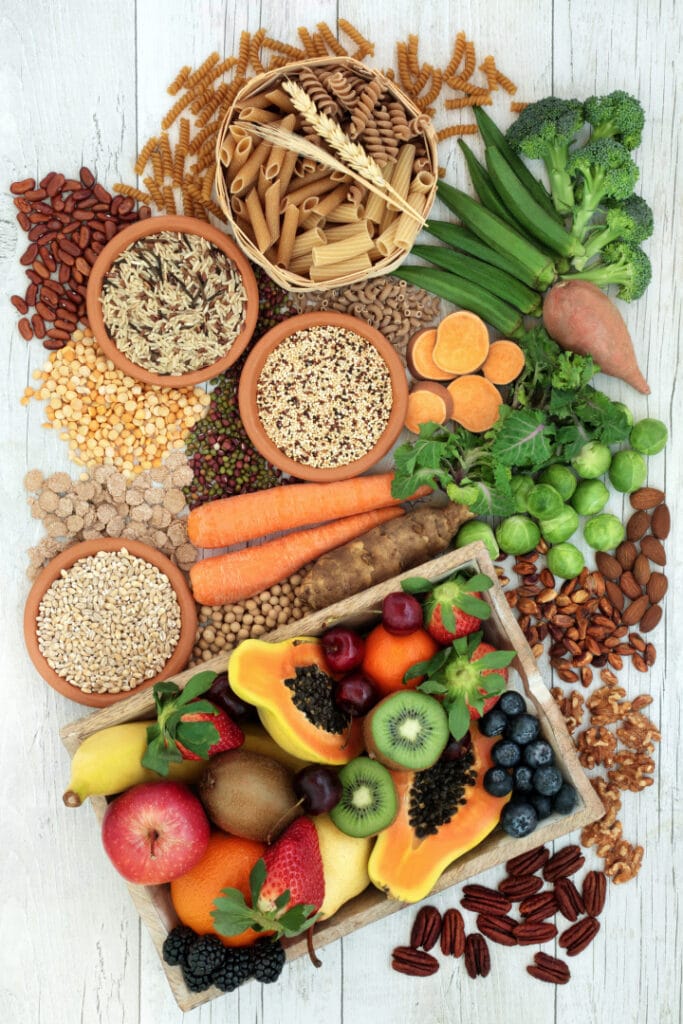
But what happens if your lunch consisted of a chicken breast and a cup of yogurt? These products don’t come from plants–and that means they have no fiber at all. Not a speck. So when your liver sends hormones or other chemicals into the intestinal tract, there is nothing for them to attach to. They end up being reabsorbed back into your bloodstream, and the whole process starts over again.
This endless cycle–hormones passing from the bloodstream, through the liver, into the intestinal tract, and, unfortunately, back into the bloodstream–is called enterohepatic circulation. It keeps hormones circulating for longer than they should. Fiber stops this cycle by carrying hormones out once and for all.
Fiber reduces cancer risks
Fiber has another function you should know about. It may reduce your risk of colon cancer.1 Fiber moves intestinal contents along, so that whatever carcinogens (that is, cancer-causing chemicals) may be lurking in your waste products are escorted out of the body more quickly.
Carcinogens don’t just come from factory waste and air pollution; they are sometimes present in foods. For example, when chicken, fish, or red meat is cooked at a high temperature (high enough to cook it), cancer-causing chemicals called heterocyclic amines tend to form as the protein molecules and other parts of muscle tissue are distorted by the intense heat.
Needless to say, that is another good reason to avoid these products. However, the bile your body produces to digest fats can also encourage the production of carcinogens. A high-fiber diet helps move these compounds out of your body.
Daily fiber intake
So, where do you find the fiber you need? Animal products don’t have any. That goes for red meat, poultry, fish, eggs, and dairy products, which is why people who center their diets on these foods often struggle with constipation.
On the other hand, plant products in their natural state have quite a lot of fiber, which is why vegetarians rarely have any need for laxatives. The first key to building a high-fiber diet is to eat plenty of vegetables, fruits, beans, and whole grains and to avoid animal products.
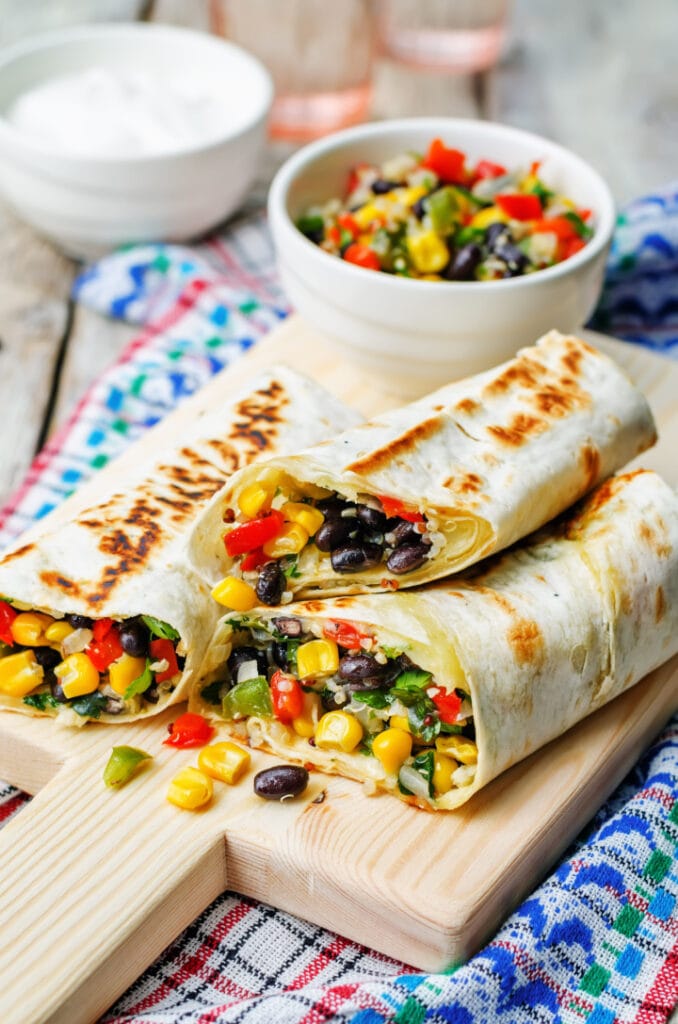
But a meaty diet is not the only wrong turn you can take. Let’s say that for breakfast you had a choice between old-fashioned oatmeal with whole-grain toast on the one hand, and a bagel and jam on the other. The first breakfast is loaded with fiber, but a bagel has very little. It is made from white flour–that is, wheat flour whose fiber has been removed in the refining process. Refining makes it soft and white, but it leaves flour almost devoid of fiber.
If you choose whole-grain bread instead of white bread, you’ll get much more fiber. The same is true for brown rice, which retains the grain’s tan-colored outer layer, as opposed to white rice, which has lost this high-fiber layer in the refining process.
Generally speaking, the most fiber-rich foods are beans and vegetables, followed by fruits and whole grains. Yes, breakfast cereals and other grain products advertise their high-fiber content. But, you’ll find surprisingly large amounts of it in simple bean and vegetable dishes.
Fiber comes in two forms
- Soluble fiber- is the kind that disolves in water, in the way that oatmeal, for example, gets creamy as it cooks. There is also plenty of soluble fiber in beans, barley, and serveral other foods. Soluble fiber is especially known for its ability to control cholesterol levels.
- Insoluble fiber- which is found in vegetables, fruit, wheat, rice, and many other grains is visibly different. Rice and wheat grains don’t get “gooey” the way oatmeal does. Insoluble fiber is especially helpful for keeping the intestinal contents moving along and fighting constipation.
From the standpoint of cancer prevention,2 you’ll want to get both kinds. If your diet is rich in beans, vegetables, fruits, and whole grains, you’ll get plenty of healthful fiber.

How much fiber should you aim for daily?
An average American gets only 10-15 grams of fiber per day. Health authorities would like to see that number rise significantly. A sensible and easily reached goal is 40 grams per day.
Having said that, you may wish to reach this goal gradually, rather than in one jump. It may take a few weeks for your digestive tract to get used to the change.
Whole grains, such as brown rice and old-fashioned oatmeal, are pretty easy to digest. You’ll find that cruciferous vegetables, such as broccoli, cabbage, and cauliflower, are easier to digest if they are cooked until soft.
If beans cause gas for you, start with smaller quantities, be sure they are well cooked, and try different varieties.
Quick Fiber Check (PDF)
This Quick Fiber Check from PCRM is a handy little tool. Using its simple scoring concept, which takes only a minute or two to learn, you’ll be able to estimate the fiber content of virtually everything in the grocery store and calculate your own fiber intake.
To check your meals, write down everything you eat or drink for one full day on the form that follows. Next to each food, jot in its fiber score, using the following guide.
High fiber food list
- Beans- For each half-cup serving of beans or lentils or any food that includes about this amount of beans or lentils as an ingredient, mark 7. That is the number of grams of fiber in a serving. One cup of soymilk or one-half cup of tofu rates 3 grams.
- Vegetables- For each one-cup serving of vegetables, mark 4 grams. An exception is lettuce, for which one cup scores 2 grams. A potato with skin scores 4 grams; without the skin, it scores 2.
- Fruit- For each medium piece of fruit (for example, an apple, orange, or banana, one cup of applesauce, or a banana smoothie), mark 3 grams.
- Grains- For each piece of white bread, bagel, or equivalent, score 1 gram. Whole-grain breads score 2 grams. One cup of cooked pasta scores 2 grams. One cup of rice scores 1 gram for white and 3 grams for brown. One cup of cooked oatmeal scores 4. Score 3 for typical read-to-eat cereals, 1 for highly processed and colored cereals, and 8 grams for bran, or check the package information for grams of fiber.
- Meat, poultry, or fish- Score 0 grams. Animal products do not contain any fiber.
- Eggs or dairy products- Score 0.
- Sodas & water- Score 0 grams.
Interpreting your Quick Fiber Check score
- Less than 20 grams- You need more fiber in your diet. As it is, your appetite will be hard to control, and you may have occasional constipation. Boosting fiber will help tame your appetite and can cut your risk of many health problems.
- 20 to 39 grams- You are doing better than most people in Western countries, but as you bring more fiber into your diet, you will find that it makes foods more satisfying and cuts your calorie intake a bit.
- 40 or more grams- Congratulations! You have plenty of healthful fiber in your diet. It tames your appetite and helps keep you healthy. Fiber also reduces your risk of cancer,2 heart disease, diabetes, and digestive problems.
Downloadable Fiber Forms:
This article is from the book, The Cancer Survivors Guide, by Dr. Neal Barnard, M.D. and published by Book Publishing Company, Summertown, TN. Published here with permission.
Another article from Dr. Barnard is Losing Weight on a Plant-Based Diet.
About the author

Neal Barnard, M.D. is a physician, clinical researcher, author, a fellow of the American College of Cardiology, and an adjunct associate professor of medicine at the George Washington University School of Medicine and Health Sciences.
As president of the Physicians Committee for Responsible Medicine (PCRM), Dr. Barnard leads programs advocating for preventive medicine, good nutrition, and higher ethical standards in research. His research contributed to the acceptance of plant-based diets in the Dietary Guidelines for Americans. In 2015, he was named a Fellow of the American College of Cardiology. In 2016, he founded the Barnard Medical Center in Washington, D.C., as a model for making nutrition a routine part of all medical care.
Working with the Medical Society of the District of Columbia and the American Medical Association, Dr. Barnard has authored key resolutions, now part of AMA policy, calling for a new focus on prevention and nutrition in federal policies and in medical practice. In 2018, he received the Medical Society of the District of Columbia’s Distinguished Service Award. He has hosted four PBS television programs on nutrition and health.
Dr. Barnard works with patients with diabetes, obesity, and other chronic conditions in clinical research studies, aiming to improve the prevention and treatment of these health problems.
Recommended high-fiber recipes
Eating a high-fiber diet doesn’t mean meals of just salads and rabbit food. Try some of these delicious Plant-Based Recipes that are loaded with both soluble and insoluble fiber that is terrific for your gut health. These are a few of our favorites.
- Black Bean Burgers
- Teriyaki Tofu with Broccoli
- Easy Breakfast Potatoes
- Broccoli Salad
- Chickpea Avocado Salad
For those of you new to the whole food plant-based lifestyle, we’ve created a FREE 7-Day Plant-Based Menu Planner to help you get started!
Other scientific articles on WFPB nutrition
- Vegan Sources of Calcium
- A Physician’s Perspective on COVID-19, Inflammation, & Nutrition
- Protein: The Building Block of Life
- How to Start a Plant-Based Diet: Fast Way vs Slow Way
- Healthiest Foods to Eat Daily
- Top Plant-Based Doctors and Experts
- Diet for Heart Health and More
- The Starch Solution | Dr. McDougall’s Personal Journey
Citations
- Ben Q, Sun Y, Chai R, Qian A, Xu B, Yuan Y. Dietary fiber intake reduces risk of colorectal adenoma: a meta-analysis. Gastroenterology. 2014;146(3):689-699.
- Chan CW, Lee PH. Association between dietary fibre intake with cancer and all-cause mortality among 15 740 adults: the National Health and Nutrition Examination Survey III. J Hum Nutr Diet. 2016. Published ahead of print June 14, 2016.


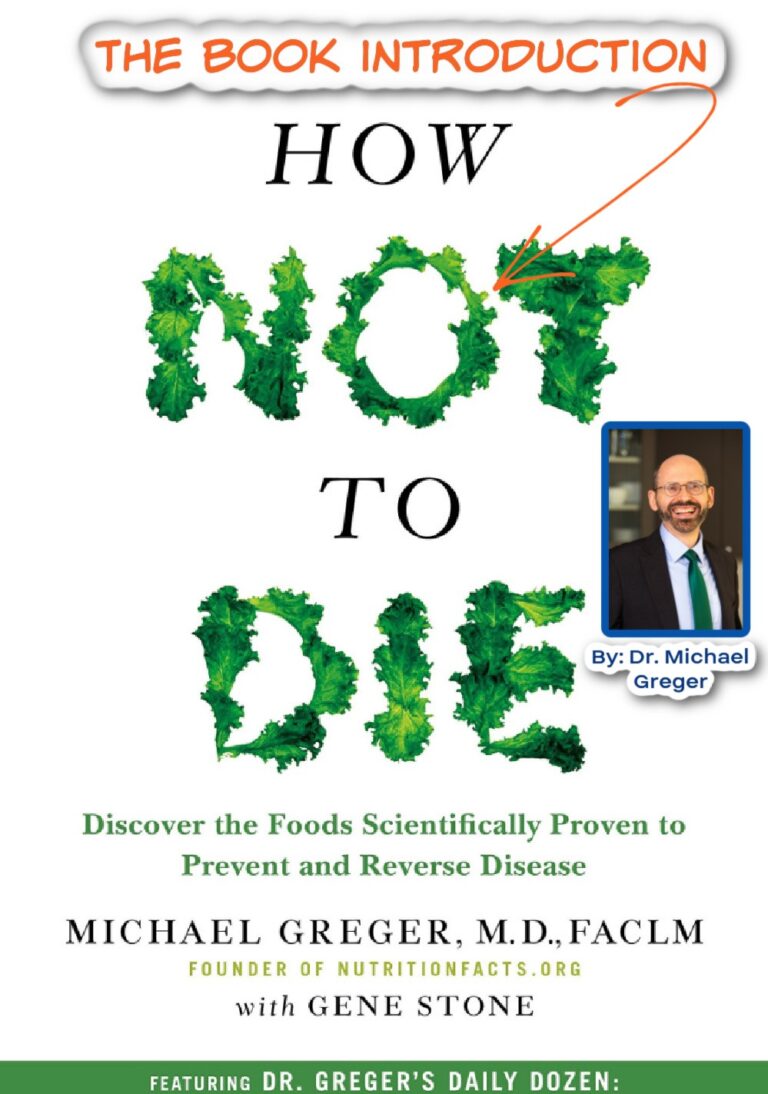
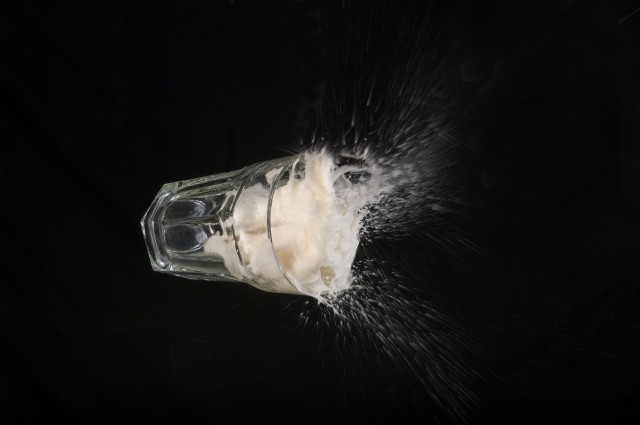




Dr. Barnard does a great job of explaining what fiber does for us. Thanks!